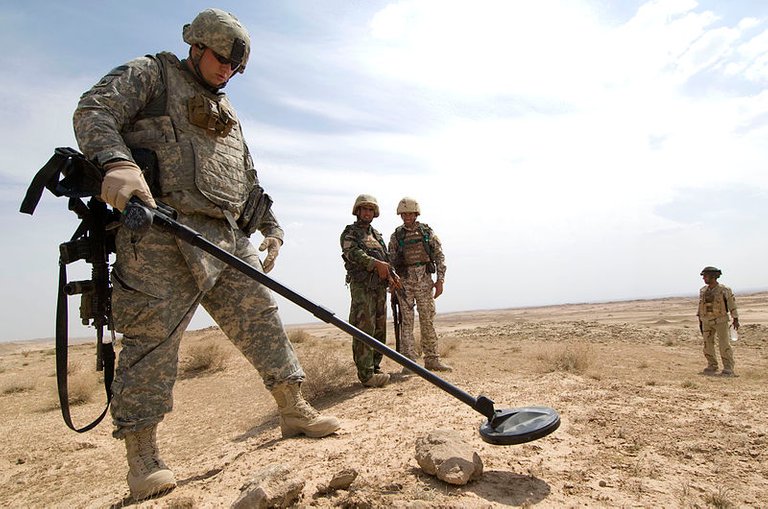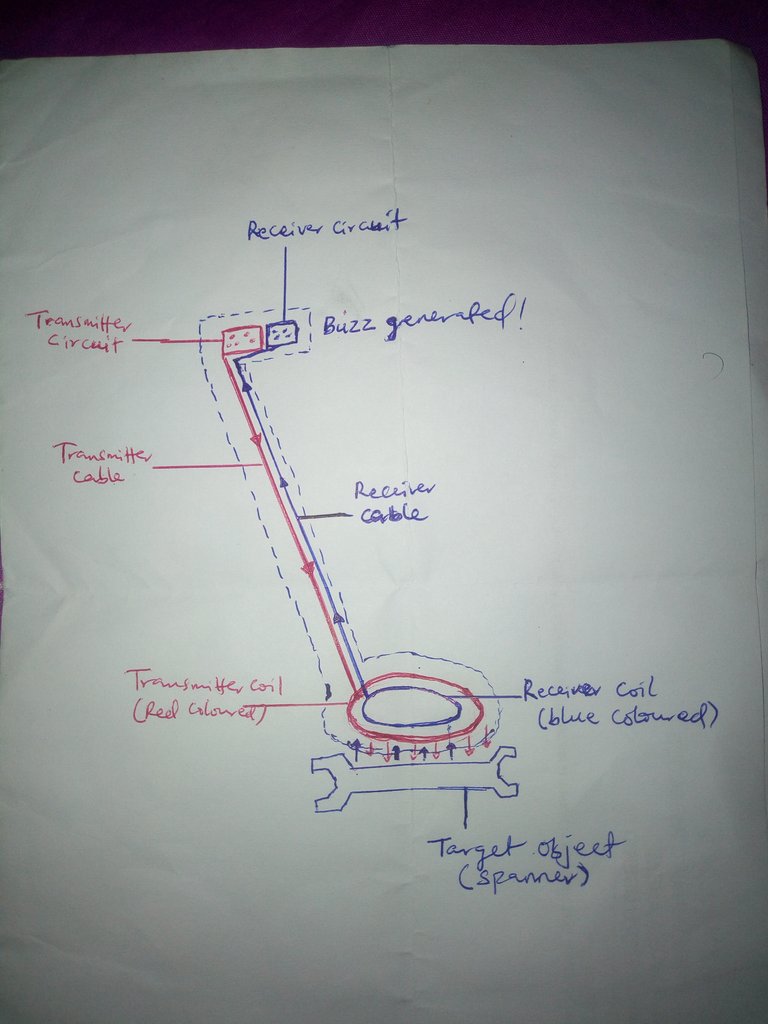The mention of metal detector means different things to different people. Where some may understand it to be a device that is used to comb beaches in search of relics and treasures, others may understand it to be an instrument used for routine security checks at airports, prisons, schools, office buildings and government agencies. What people think in both of these scenarios are valid because metal detector technology has a range of uses relating to work, leisure and safety.

[Pictogram of metal detector. Source: Wikimedia commons. Author: NPS Graphics, converted by User: ZyMOS. Public domain licensed]
Consumer targeted metal detectors are used in prospecting for easy location of valuable metals like coins, silver, gold, copper and other hidden treasures in their natural form where they may have been buried from time immemorialref. An instance of this, is the discovery of Mojave (gold) nugget in Southern California by the use of a metal detectorref. Metal detectors in office buildings, airports, hospitals, etc are used to ensure security so that people don't bring in dangerous weapons into these premises. Based on the foregoing prelim, we can define metal detector as...
...an electronic instrument which detects the presence of metal nearby. Metal detectors are useful for finding metal inclusions hidden within objects, or metal objects buried underground. | Source
With that being said, in this article I wrote some days ago, I discussed very extensively how electricity and electromagnetism are two different faces of the same coin because where you find one, you must also find the other. And this property is essentially the principle on which transformers operate to either step up electrical voltages or step them down. It turns out that metal detectors are also based on the principle of electromagnetism. In this article, we are going to be looking at how they work, with focus on the Very Low Frequency (VLF) based metal detectors, which is the simplest technology used by metal detectors, even though some of the information here are also true for both walk-through metal detectors at airports and handheld security scanners.
Components of a metal detector and its operation
At this point, i think getting to know the various components of a simple VLF based metal detector, will be essential to understanding the science of metal detectors, which comes after. A typical metal detector must not be heavy for ease of usage, and is made up of the following elements:
Stabilizer: this is optional and it is used to steady the unit as it is being moved back and forth over the test area.
Control box: this is a chamber housing speaker, batteries, circuitry, microprocessor and the controls.
Shaft: this provides connection between the control box and the coil, and it can be adjusted in accordance with the operator's height.
Search coil: this is the part that actually probes the test area for the hidden metal. It can also be called the search head, loop or antenna.

[Source: Wikimedia commons. Author: The US Army. Public domain licensed]
Operating a metal detector involves turning the unit on, and then moving it back and forth over the area being searched for possible presence of the object of interest. Once it is passed over an area housing the object of interest, it would emit an audible sound or signal and thus alerts the operator of the presence of the object of interest within the area under consideration.
Science of metal detectors
Metal detectors work in accordance with the laws of electromagnetism as first expounded by a Scottish physicist named James Clerk Maxwell (1831 — 1879) who, in the 1860s, summed up the interactions between an electromagnet and electricity in four formulas called Maxwell's equations. According to these equations, changing electric current along the coil of a metal wire will always produce changing magnetic field around the metal wire.
Conversely, changing magnetic flux around the coil of a metal wire will always induce electric current on the metal wire. To put it in simple terms, according to Maxwell, electricity and magnetism are related, and this relationship is captured by the term electromagnetism. Having a good knowledge of this relationship is an important prerequisite to understanding how metal detectors work.
How metal detectors work
I have searched the internet for appropriate licensed image to help drive home the point of this section to no avail. So we are going to use the below rough sketch for better understanding of how a typical metal detector works. Having said that, when the battery of a metal detector is turned on, the system is activated and so the transmitter circuit (red) sends electricity along the transmitter cable down to transmitter coil (red) at the bottom of the device. Electricity flowing through the transmitter coil generates a magnetic field around the coil. Assuming the device is moved back and forth over a target object (spanner), the magnetic field generated around the transmitter coil would penetrate the spanner and induce an electric current to flow round the spanner.

Because this electric current keeps changing, it would cause another magnetic field round the spanner. This magnetic field flows across, penetrating the receiver coil (blue) in the base of the device and creates a weak electric current, which is then amplified and transmitted through the receiver cable to the receiver circuit (blue) at the top. And thus completing the chain of the electromagnetic process, making the device's loudspeaker to buzz and alert the operator that something has been found.
This brings us to the end of this article titled The Science behind metal detectors. Thanks for reading.
References for further reading
Yours truly,
@eurogee
Do You Blog About Science, Technology, Engineering, and Mathematics? If Yes, Patiently Read The Below Info


Join Euronation Community on Telegram and whatsapp through the below links to socialize with larger steemit community:

No Witnesses = No Steem Blockchain; If You Truly Love Here, Vote For Witnesses NOW!
Click This Link To Vote Now


well-researched. God bless
may i like your post i have to learn a lot with you buddy
By. @adit123
Well research write-up,
Awesome post about metal detectors and how they make good use of electromagnetism.
Basically, most of our household appliances make use of electricity and electromagnetism to function too. Ranging from radios, televisions to fans, the list is endless.
However, the most amazing of its applications, apart from these metal detectors i just read about today, is the magnetic card reading system(the stripe card) on modern doors. The cards here are coded by a solenoid which uses electromagnetism and the card reader too reads the card by making use of electromagnetism. The uses of electricity and electromagnetism can never be exhausted
Exactly my friend @purelyscience. Thanks for your opinion and finding time to be here
@eurogee
Nicely written @eurogee, however, I've got a question. You made mention of target object, I've seen this device being used to check vehicles at security checkpoints, a car is made up of mainly metal so how does this device differentiate one type of material from another? Or better still, how can one choose or select object of interest?
My dear @henrychidiebere! I know it can only be you always with your intelligent questions. Thanks for visiting my blog and for asking such an important question. I really envisaged a question such as yours coming, and would have included the details in this article in the first place, but I didn't because the article was getting too long and I like to keep my writings within readable threshold, and then engage people with questions with further details in the comment section.
Now, in response to your question; Very Low Frequency based metal detectors employ what's known as phase shifting phenomenon which confers a sort of discrimination capacity on such detectors, enabling them to distinguish between different metals with very high detection accuracy.
For instance, an object that is a good conductor of electricity would be slow to respond to changes in the current. In this case, we say that the object is of high inductance because it allows electricity to pass through it easily. One way to appreciate this is to think of inductance as a deep river. It would certainly take some time to notice a change in the amount of water flowing into such a water body.
On the other hand, an object that is a bad conductor of electricity would be very quick to respond to changes in the current owing to its high resistance. Applying our water analogy above in this case, we think of resistance as a shallow stream of water. Now, change the amount of water flowing into a stream and the change will be easily noticed.
On the basis of the foregoing discourse, a target object with high inductance value would equally have high phase shift value because it would certainly take some time to sufficiently change its associated magnetic flux. And the reverse is true for a target object with high resistance.
Attention @henrychidiebere
VLF metal detectors use a discrimination feature known as phase modulators. And since different metals (target objects) have different inductance and resistance values, when the vehicle comes under the scrutiny of a VLF metal detector, the detector by simply using its phase modulation discrimination technology probes the different metal components of the vehicle and compares their values with a particular type of metal being searched for. Should the reading falls within the range a target object would likely have, the vehicle will be suspected and taken into custody for further investigation. It's been exhaustive response. Thank you.
Sourced from
Boss @eurogee
Thanks for this great effort. This is succinctly put and well appreciated.
@sciencetech
STEM contributor
This post has been voted on by the steemstem curation team and voting trail.
There is more to SteemSTEM than just writing posts, check here for some more tips on being a community member. You can also join our discord here to get to know the rest of the community!